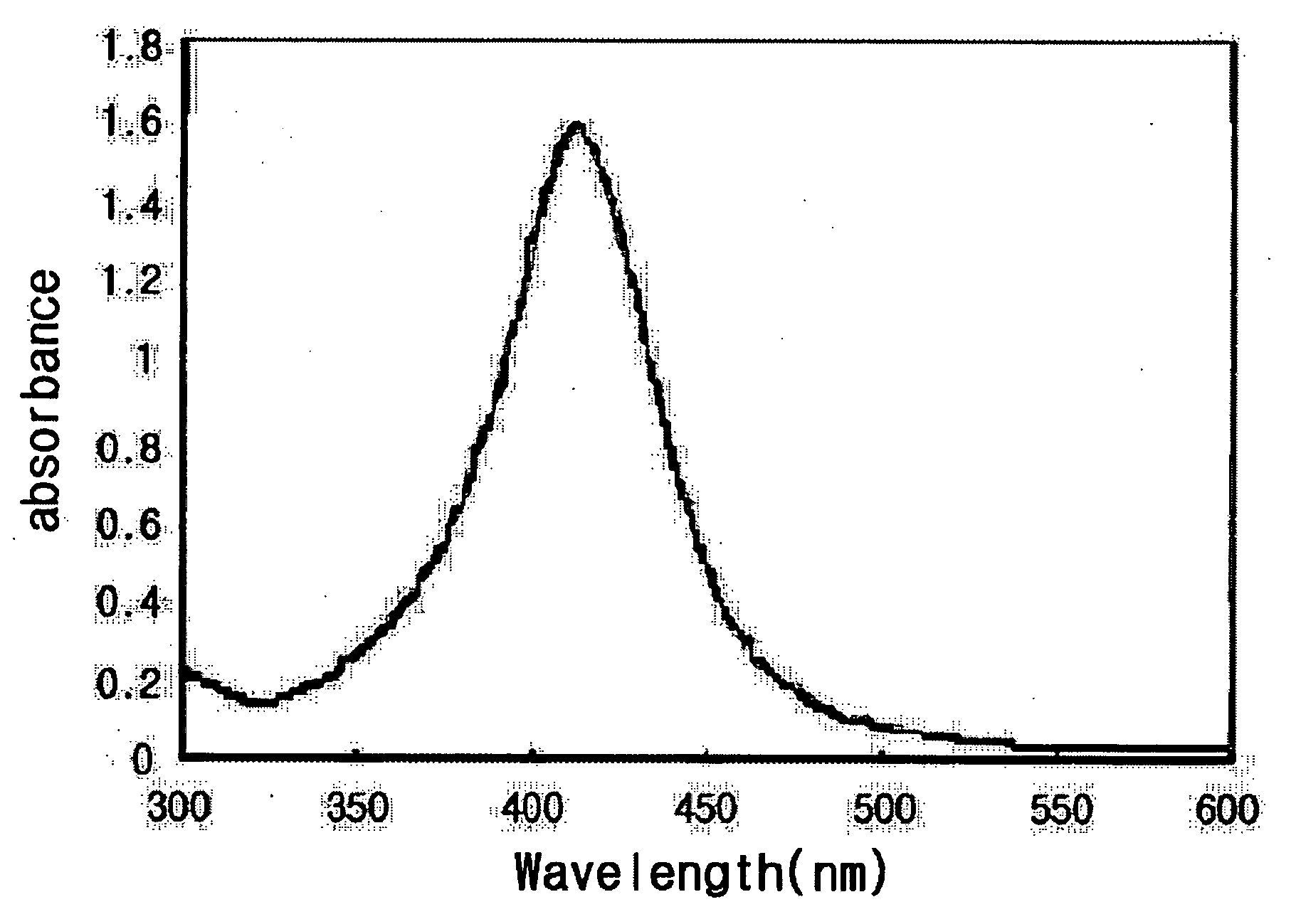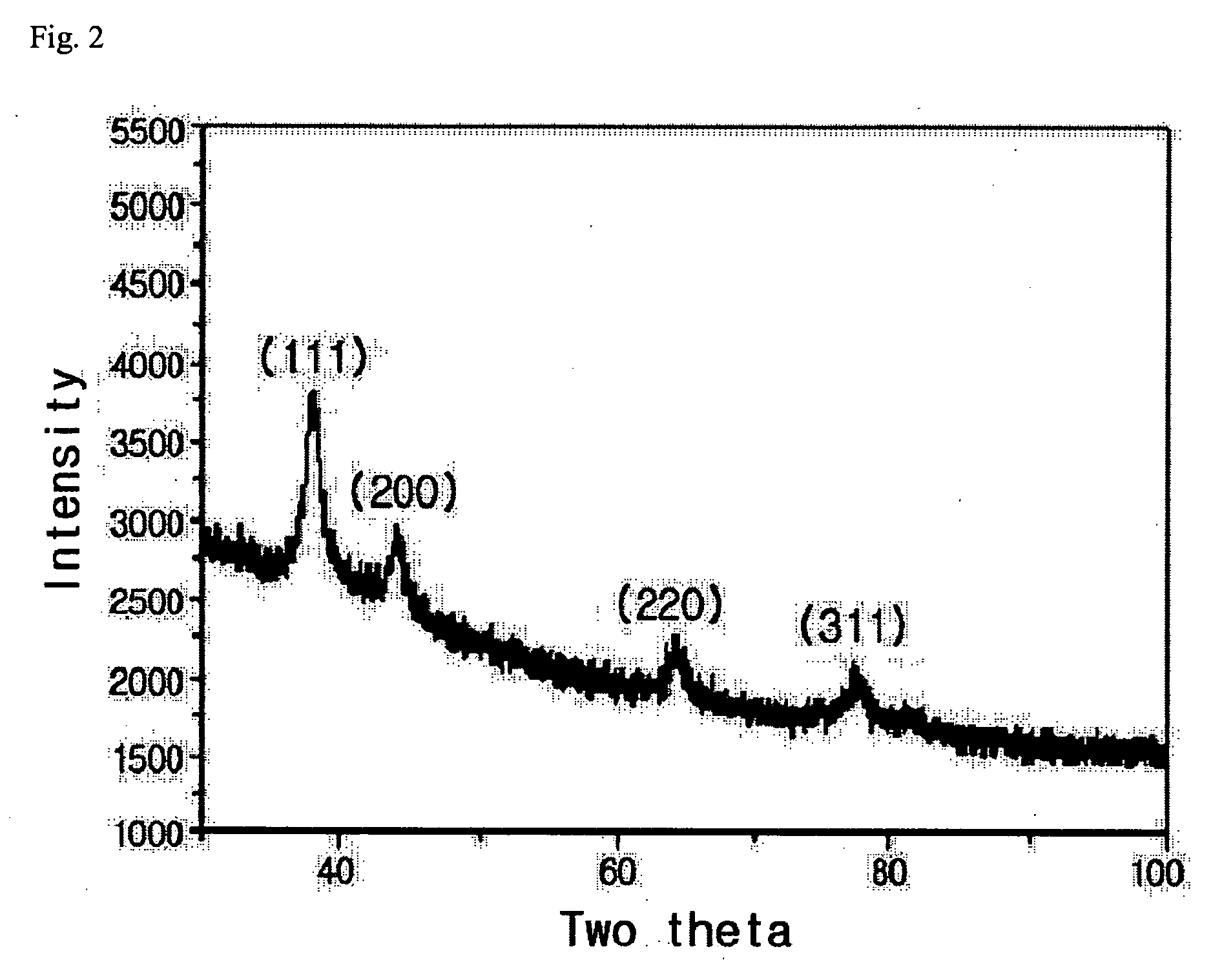Metal nanoparticles and method for producing the same
a metal nanoparticle and metal nanoparticle technology, applied in the direction of non-metal conductors, conductors, transportation and packaging, etc., can solve the problems of high equipment cost, limited synthesizing small-sized metal nanoparticles of 30 nm or less, and insufficient solvent selection and cost. , to achieve the effect of high yield rate and high equipment cos
- Summary
- Abstract
- Description
- Claims
- Application Information
AI Technical Summary
Benefits of technology
Problems solved by technology
Method used
Image
Examples
example 1
[0030] 0.03M of NaOH solution dissolved in 40 ml of distilled water was added to 0.03M of lauric (dodecanoic) acid solution dissolved in 40 ml of methanol and agitated for 30 minutes. Here 0.03M of AgNO3 solution dissolved in 40 ml of distilled water was mixed gently to obtain white silver-dodecanoate precipitate. After isolating by filtration, the precipitate was washed with distilled water and methanol, followed by drying at 50° C. for 12 hours. The solid silver-dodecanoate complex was deposited in a Pyrex ware and heated to 190° C. for 3 hours in a vacuum oven, to produce silver nanoparticles.
[0031] As shown in FIG. 1, the result of UV measurement presents the typical absorbance peak around 420 nm range, which appears when silver nanoparticles are generated.
[0032] In FIG. 2, the result of X ray diffraction analysis shows that the diffraction peak was observed at the degree of 38.2°, 44.5°, 64.5° as indicated as (111), (200), (220), which ensures that silver without impurities w...
example 2
[0033] After 0.03M of AgNO3 was dissolved in 300 ml of distilled water, sodium oleate was added and agitated for 1 hour to precipitate bright ivory colored silver-oleate. Then isolated by filtration, the precipitate was washed with distilled water and methanol, followed by drying at 50° C. for 12 hours. The solid silver-oleate complex was deposited in a Pyrex ware and heated to 270° C. for 1 hour in a muffle furnace, to produce silver nanoparticles.
[0034] The generation of silver nanoparticles was confirmed by the UV measurement as shown in FIG. 1, and the production of silver nanoparticles was confirmed by the X ray diffraction assay as shown in FIG. 2.
[0035] The result of TEM analysis of FIG. 4 ensures that silver nanoparticles having spherical shape and uniform size distribution with a range of 6 to 8 nm were generated.
example 3
[0036] 0.01M of NaOH solution dissolved in 100 ml of distilled water was added to 0.01M of palmitic (hexadecanoic) acid solution dissolved in 100 ml of methanol and agitated for 30 minutes. Here, 0.01M of AgNO3 solution dissolved in 100 ml of distilled water was mixed gently to obtain white silver-palmitate precipitate. After isolating by filtration, the precipitate was washed 3 times with distilled water and once with methanol , followed by drying at 50° C. for 12 hours. The solid silver-palmitate complex was deposited in a Pyrex ware and heated to 260° C. for 2 hours in a vacuum oven, to produce silver nanoparticles. The result of TEM analysis of FIG. 5 ensures that silver nanoparticles having uniform size distribution with a range of 4 to 6 nm were generated.
PUM
| Property | Measurement | Unit |
|---|---|---|
| size | aaaaa | aaaaa |
| size | aaaaa | aaaaa |
| temperature | aaaaa | aaaaa |
Abstract
Description
Claims
Application Information
 Login to View More
Login to View More - R&D
- Intellectual Property
- Life Sciences
- Materials
- Tech Scout
- Unparalleled Data Quality
- Higher Quality Content
- 60% Fewer Hallucinations
Browse by: Latest US Patents, China's latest patents, Technical Efficacy Thesaurus, Application Domain, Technology Topic, Popular Technical Reports.
© 2025 PatSnap. All rights reserved.Legal|Privacy policy|Modern Slavery Act Transparency Statement|Sitemap|About US| Contact US: help@patsnap.com



